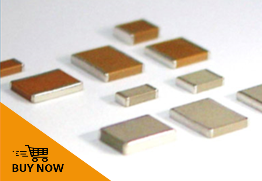The demand for multi-layer ceramic capacitors – MLCCs – has increased tremendously in recent years. These days each and every smart phone contains an average of 750 to 1,000 MLCCs, and a car can contain as many as 3,000 – and the trend is upwards. At Murata, the demand for MLCCs has risen by a factor of 2.5 over the past four years. Many manufacturers are continually expanding their production capacity, but on their own, they cannot cover the constantly increasing demand.
One remedy is to downsize. Because smaller sizes allow much greater production output, as against larger sizes. Compared with 1210 MLCCs, alone from the pure surface of the same wafer it is possible to obtain around 16 times as many 0402s and 44 times as many 0201s. In terms of volume, the production output increases by a factor of 80 (0402) or of 400 (0201) (Image 1).
That is why it is recommended to use smaller sized MLCCs, provided the required value combinations are available. This applies in particular to new product developments, but to redesigns too. So valuable production capacities can be maintained for high capacitance MLCCs that cannot be produced in smaller sizes, but they are not straightjacketed by having to make parts that are available in smaller sizes.
Downsizing offers other benefits
Other areas also benefit from component downsizing. This is because smaller components make it possible to cut costs beyond the low component price, by requiring less PCB space, weighing less, needing less solder and above all, requiring less storage space
In order to fully exploit the potential, it is necessary to consider a few things. Starting by not simply looking at existing value combinations, but by examining the application’s actual requirements and ultimately even the MLCCs’ function. This is particularly true for the capacitance and voltage values, but also for the necessary temperatures and impedance/ESR values. To this is added the DC bias, especially with HiCaps, i.e. capacitors with capacitance in the µF range. DC bias is an effect whereby the MLCCs’ capacitance is reduced in accordance with the voltage applied. That means it is necessary to check that in operation it does not fall below a particular C-value threshold.
With low capacitance MLCCs, such as interference bypass capacitors in the 100nF range at 16V, the impedance curve barely differs for the 0603, 0402 and 0201 designs. In general the smaller the design, the better the impedance properties
For high capacitance MLCCs, such as buffer capacitors in the range of a few µF the smaller designs indicate a similar wider capacitance drift with temperature but a more pronounced DC bias
If higher nominal capacitance values are used, we achieve even higher actual (residual) capacitance values throughout in real operating conditions
For ceramic capacitors, such as those with 100pF and 50V the electrical properties of the 0603 and 0201 sizes are almost identical











